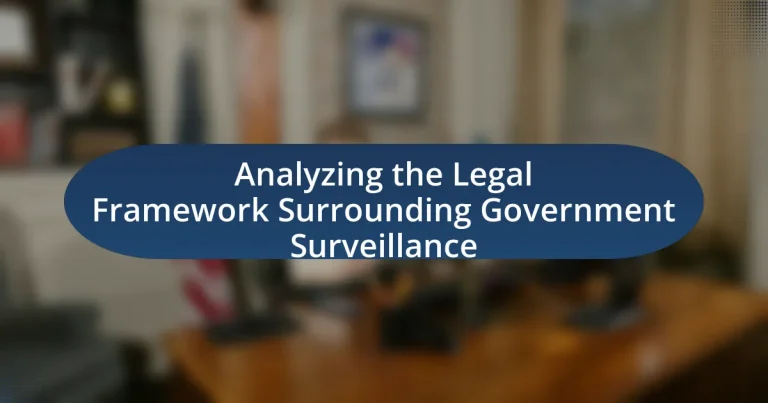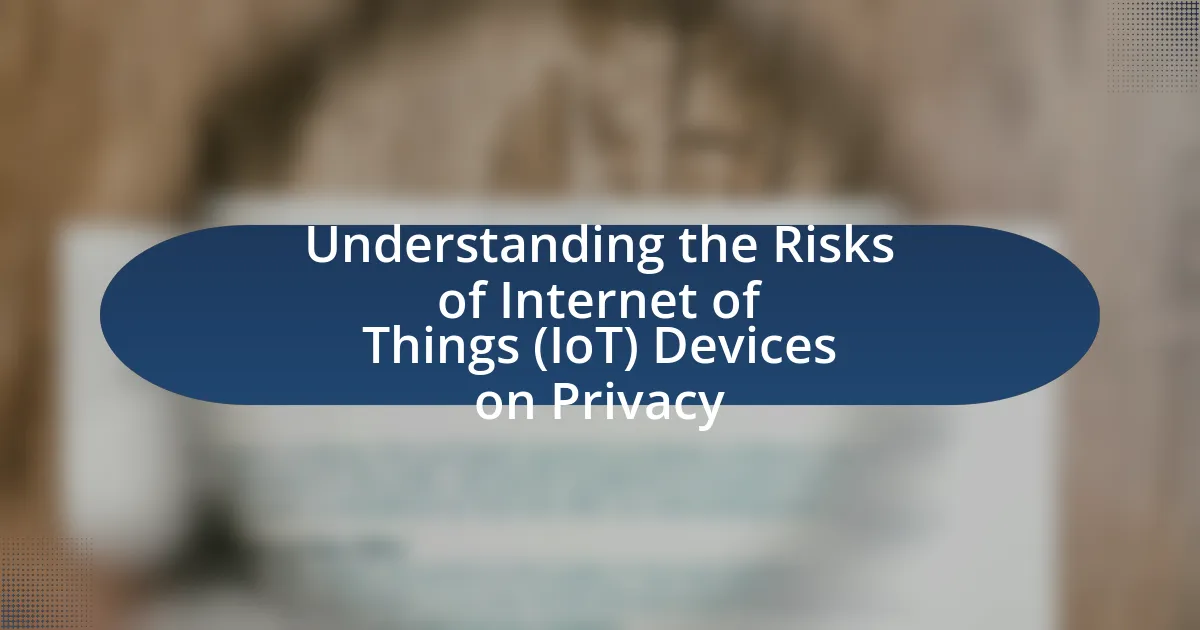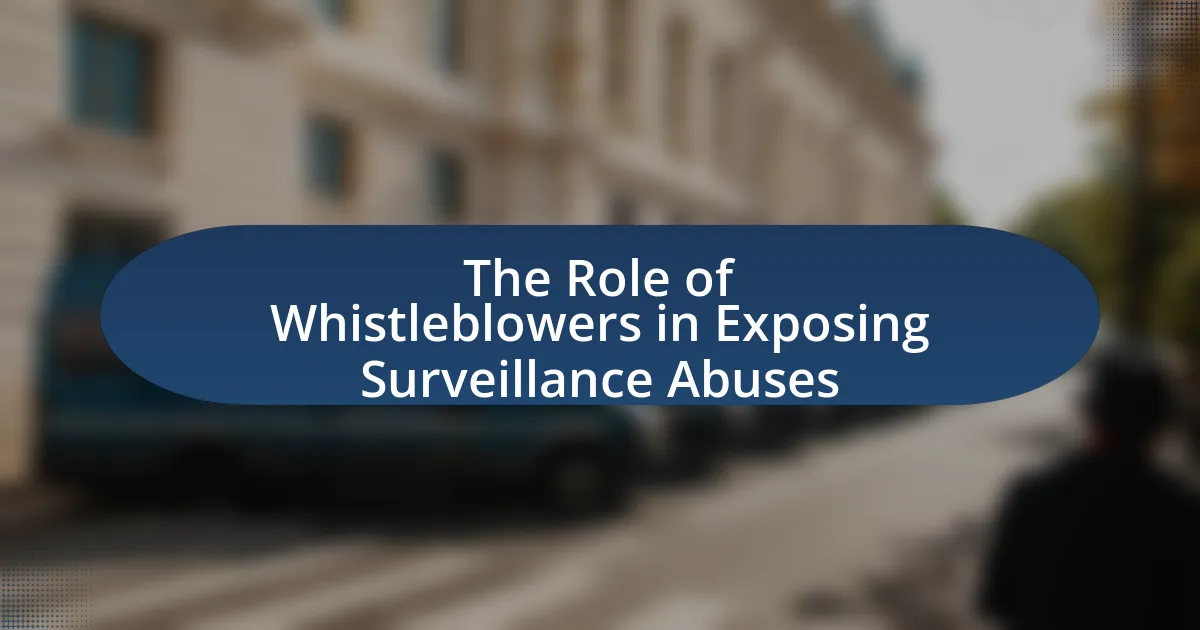The article analyzes the legal framework surrounding government surveillance, focusing on the laws, regulations, and judicial interpretations that dictate how government entities monitor individuals. Key components include the Fourth Amendment, the Foreign Intelligence Surveillance Act (FISA), and the USA PATRIOT Act, which collectively establish the balance between national security and individual privacy rights. The article also explores the definitions of government surveillance, key legal terms, and the implications of these laws on privacy rights and government accountability. Additionally, it addresses how technological advancements challenge existing surveillance laws and the need for legal reforms to adapt to these changes.
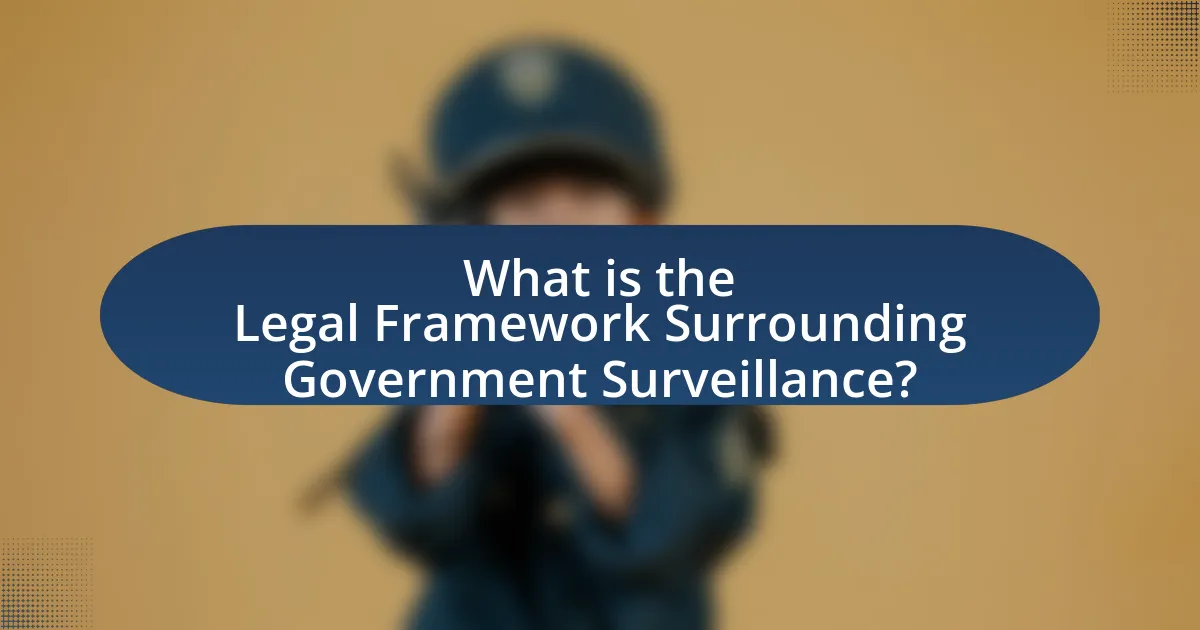
What is the Legal Framework Surrounding Government Surveillance?
The legal framework surrounding government surveillance primarily consists of laws, regulations, and judicial interpretations that govern how and when government entities can monitor individuals. In the United States, key components include the Fourth Amendment, which protects against unreasonable searches and seizures, and statutes like the Foreign Intelligence Surveillance Act (FISA), which outlines procedures for surveillance of foreign powers and agents. Additionally, the USA PATRIOT Act expanded surveillance capabilities post-9/11, allowing for broader data collection. Courts, including the Supreme Court, have shaped this framework through rulings that balance national security interests with individual privacy rights, such as in the landmark case of Carpenter v. United States, which established that accessing historical cell phone location data constitutes a search under the Fourth Amendment.
How is government surveillance defined within legal contexts?
Government surveillance is defined within legal contexts as the monitoring of individuals or groups by government entities, typically justified under laws aimed at national security, crime prevention, or public safety. Legal frameworks, such as the Foreign Intelligence Surveillance Act (FISA) in the United States, outline the conditions and limitations under which surveillance can occur, ensuring that it adheres to constitutional protections against unreasonable searches and seizures. Courts have interpreted these laws, establishing precedents that balance governmental interests with individual privacy rights, as seen in landmark cases like Katz v. United States, which affirmed the expectation of privacy in public communications.
What are the key legal terms associated with government surveillance?
Key legal terms associated with government surveillance include “Fourth Amendment,” “FISA,” “PATRIOT Act,” “wiretap,” and “metadata.” The Fourth Amendment of the U.S. Constitution protects against unreasonable searches and seizures, establishing a legal framework for privacy rights. The Foreign Intelligence Surveillance Act (FISA) regulates the government’s ability to conduct surveillance for foreign intelligence purposes, requiring warrants for certain types of surveillance. The USA PATRIOT Act expanded the government’s surveillance capabilities post-9/11, allowing for broader access to personal information. A wiretap refers to the interception of telephone communications, which typically requires a court order. Metadata, which includes data about data (such as call times and durations), is often collected by government agencies and raises legal questions regarding privacy and surveillance. These terms are foundational in understanding the legal landscape of government surveillance practices.
How do different jurisdictions define government surveillance?
Different jurisdictions define government surveillance based on their legal frameworks, which often include specific laws, regulations, and constitutional provisions. For instance, in the United States, government surveillance is primarily governed by the Foreign Intelligence Surveillance Act (FISA) and the USA PATRIOT Act, which outline the conditions under which surveillance can be conducted, emphasizing national security and law enforcement. In contrast, the European Union defines government surveillance through the General Data Protection Regulation (GDPR) and the European Convention on Human Rights, which prioritize individual privacy rights and require strict oversight and justification for surveillance activities. These definitions reflect the balance each jurisdiction seeks between security interests and individual rights, demonstrating the diversity in legal interpretations and implementations of government surveillance across different regions.
Why is understanding the legal framework important?
Understanding the legal framework is important because it establishes the rules and regulations governing government surveillance activities. This framework ensures that surveillance practices comply with constitutional rights, such as privacy and due process, thereby protecting citizens from potential abuses of power. For instance, the Fourth Amendment of the U.S. Constitution safeguards against unreasonable searches and seizures, which directly impacts how surveillance can be conducted. Additionally, knowledge of laws like the Foreign Intelligence Surveillance Act (FISA) informs stakeholders about the legal boundaries and oversight mechanisms in place, promoting accountability and transparency in government actions.
What implications does the legal framework have on privacy rights?
The legal framework significantly impacts privacy rights by establishing the boundaries within which government surveillance can occur. This framework, including laws such as the Fourth Amendment in the United States, dictates the extent to which authorities can monitor individuals without infringing on their rights to privacy. For instance, the Supreme Court ruling in Carpenter v. United States (2018) highlighted that accessing historical cell phone location data constitutes a search under the Fourth Amendment, thereby reinforcing the necessity for warrants in many surveillance scenarios. Such legal precedents shape the protection of privacy rights by requiring governmental entities to justify their surveillance actions, thus balancing state interests with individual freedoms.
How does the legal framework affect government accountability?
The legal framework significantly affects government accountability by establishing rules and standards that govern the actions of public officials and agencies. This framework includes laws, regulations, and judicial interpretations that define the limits of government power and the rights of citizens. For instance, the Freedom of Information Act mandates transparency, allowing citizens to request access to government records, thereby holding officials accountable for their actions. Additionally, legal mechanisms such as checks and balances, judicial review, and oversight committees ensure that government actions can be challenged and scrutinized, reinforcing accountability. Historical examples, such as the Watergate scandal, illustrate how legal frameworks can lead to investigations and consequences for government misconduct, thereby promoting accountability.
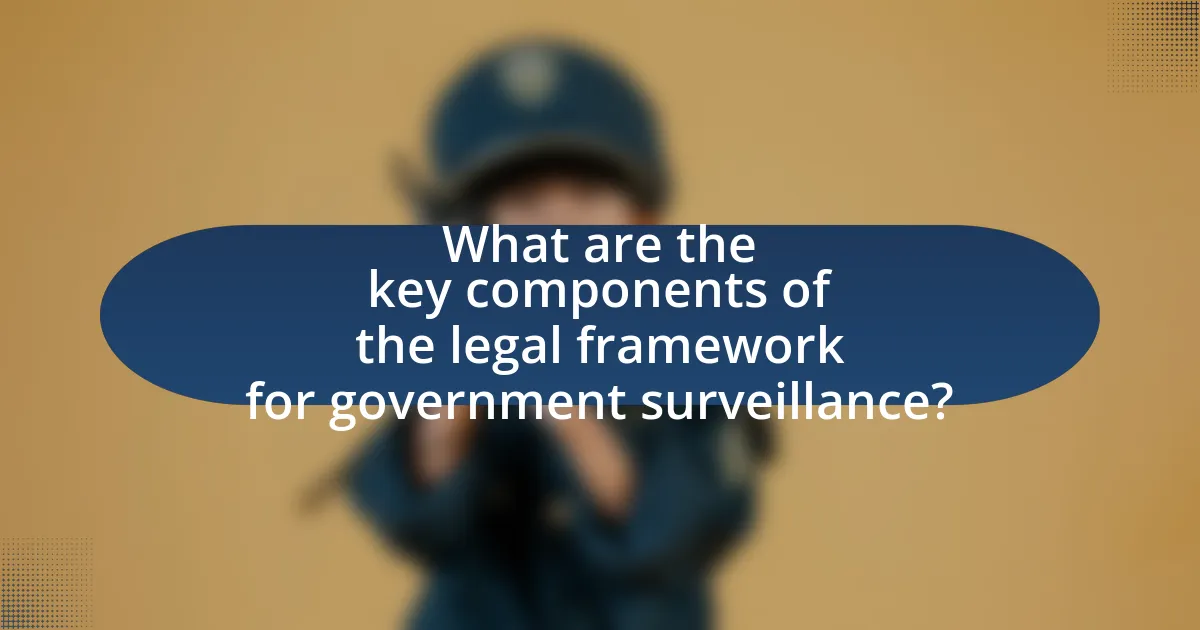
What are the key components of the legal framework for government surveillance?
The key components of the legal framework for government surveillance include statutory laws, constitutional protections, judicial oversight, and regulatory guidelines. Statutory laws, such as the Foreign Intelligence Surveillance Act (FISA) and the USA PATRIOT Act, establish the legal basis for surveillance activities. Constitutional protections, particularly the Fourth Amendment, safeguard against unreasonable searches and seizures, requiring warrants based on probable cause. Judicial oversight is provided through courts that review and authorize surveillance requests, ensuring compliance with legal standards. Regulatory guidelines, often set by agencies like the Federal Communications Commission (FCC) and the National Security Agency (NSA), dictate the operational procedures for surveillance activities. These components collectively ensure that government surveillance is conducted within a legal framework that balances national security interests with individual privacy rights.
What laws govern government surveillance practices?
The primary laws governing government surveillance practices in the United States include the Foreign Intelligence Surveillance Act (FISA), the USA PATRIOT Act, and the Electronic Communications Privacy Act (ECPA). FISA, enacted in 1978, establishes procedures for the surveillance and collection of foreign intelligence information, requiring government agencies to obtain warrants from the Foreign Intelligence Surveillance Court. The USA PATRIOT Act, passed in 2001, expanded the government’s surveillance capabilities, allowing for greater access to personal data in the interest of national security. The ECPA, enacted in 1986, regulates government access to electronic communications and stored data, requiring law enforcement to obtain a warrant for certain types of surveillance. These laws collectively shape the legal framework for government surveillance, balancing national security interests with individual privacy rights.
How do national security laws influence surveillance activities?
National security laws significantly influence surveillance activities by providing the legal framework that enables government agencies to conduct monitoring and data collection. These laws, such as the USA PATRIOT Act and the Foreign Intelligence Surveillance Act, grant authorities broad powers to surveil individuals suspected of threats to national security, often without the need for a warrant. For instance, the USA PATRIOT Act expanded the government’s ability to access personal data from telecommunications and internet service providers, thereby facilitating extensive surveillance operations. This legal backing allows agencies to justify their surveillance practices under the premise of protecting national security, often leading to debates about privacy rights and civil liberties.
What role do data protection laws play in surveillance?
Data protection laws serve to regulate and limit the extent of surveillance by establishing legal frameworks that protect individuals’ privacy rights. These laws, such as the General Data Protection Regulation (GDPR) in the European Union, impose strict requirements on how personal data can be collected, processed, and stored, thereby constraining government agencies’ ability to conduct surveillance without oversight. For instance, GDPR mandates that data collection must be lawful, fair, and transparent, requiring authorities to justify their surveillance activities and ensure that they do not infringe on individuals’ rights. This legal framework aims to balance the need for security and public safety with the fundamental right to privacy, thereby shaping the practices and policies surrounding government surveillance.
What are the constitutional considerations in government surveillance?
The constitutional considerations in government surveillance primarily involve the Fourth Amendment, which protects citizens against unreasonable searches and seizures. This amendment requires law enforcement to obtain a warrant based on probable cause before conducting surveillance, ensuring a balance between national security interests and individual privacy rights. Additionally, the First Amendment implications arise when surveillance targets individuals based on their speech or association, potentially chilling free expression. Courts have interpreted these constitutional protections through landmark cases, such as Katz v. United States, which established the “reasonable expectation of privacy” standard, reinforcing the necessity for warrants in many surveillance scenarios.
How does the Fourth Amendment relate to government surveillance?
The Fourth Amendment protects individuals from unreasonable searches and seizures by the government, establishing a legal framework that requires law enforcement to obtain a warrant based on probable cause before conducting surveillance. This constitutional protection is crucial in regulating government surveillance practices, as it aims to balance national security interests with individual privacy rights. The Supreme Court has interpreted the Fourth Amendment in various cases, such as Katz v. United States (1967), which extended its protections to electronic communications, reinforcing the necessity for warrants in surveillance activities.
What are the legal precedents affecting surveillance practices?
Legal precedents affecting surveillance practices include key Supreme Court cases such as Katz v. United States (1967), which established the “reasonable expectation of privacy” standard, and United States v. Jones (2012), which ruled that GPS tracking constitutes a search under the Fourth Amendment. These cases set foundational principles that govern the legality of surveillance methods used by law enforcement, emphasizing the need for warrants and probable cause in many instances. Additionally, the Foreign Intelligence Surveillance Act (FISA) and its amendments have shaped the legal landscape by regulating government surveillance for national security purposes, requiring oversight and judicial approval for certain types of surveillance activities.
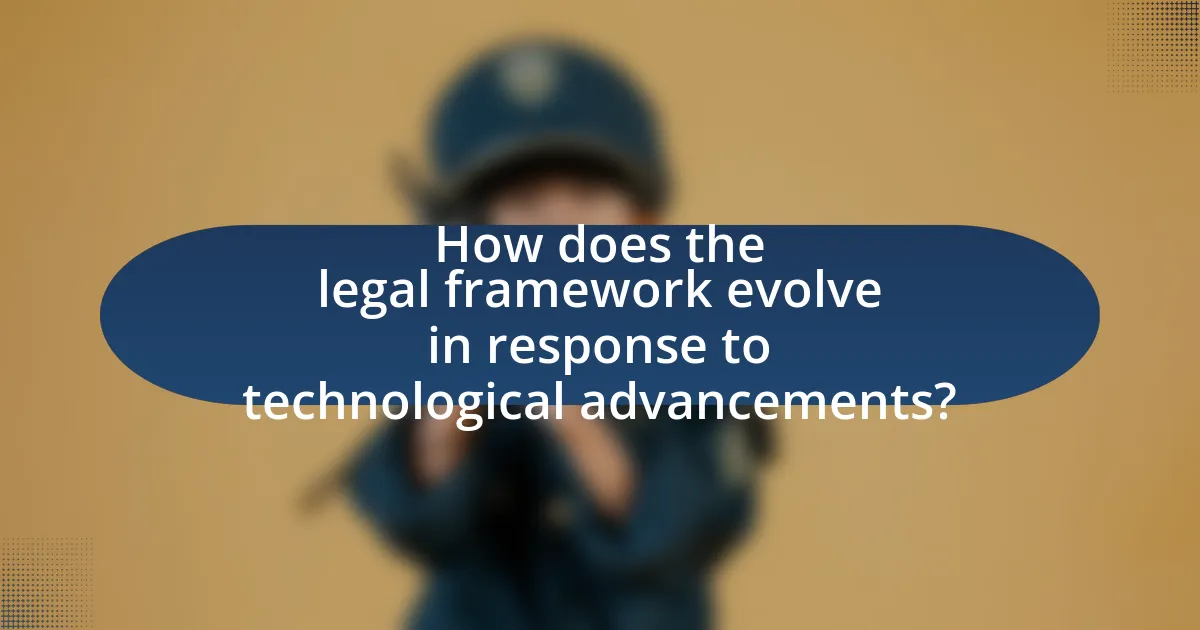
How does the legal framework evolve in response to technological advancements?
The legal framework evolves in response to technological advancements by adapting existing laws and creating new regulations to address emerging issues. For instance, the rise of digital communication technologies has prompted lawmakers to revise privacy laws, such as the implementation of the General Data Protection Regulation (GDPR) in the European Union, which was enacted to protect personal data in the digital age. This evolution is often driven by the need to balance innovation with the protection of individual rights, as seen in the U.S. with the introduction of the USA PATRIOT Act post-9/11, which expanded surveillance capabilities while raising concerns about civil liberties. Such adaptations demonstrate the legal system’s responsiveness to the challenges posed by new technologies, ensuring that regulations remain relevant and effective in safeguarding public interests.
What challenges does technology pose to existing surveillance laws?
Technology poses significant challenges to existing surveillance laws by outpacing legal frameworks designed to regulate data collection and privacy. The rapid advancement of technologies such as artificial intelligence, facial recognition, and big data analytics enables extensive surveillance capabilities that often operate in a legal gray area. For instance, the use of AI in surveillance can lead to mass data collection without explicit consent, conflicting with laws like the General Data Protection Regulation (GDPR) in Europe, which emphasizes user consent and data minimization. Additionally, the global nature of technology complicates jurisdictional issues, as data may be stored or processed in multiple countries, making enforcement of local laws difficult. These challenges highlight the need for legal reforms to address the evolving landscape of surveillance technology.
How have recent technological developments changed surveillance capabilities?
Recent technological developments have significantly enhanced surveillance capabilities through advancements in artificial intelligence, data analytics, and sensor technologies. These innovations enable real-time monitoring, facial recognition, and predictive analytics, allowing agencies to process vast amounts of data quickly and accurately. For instance, AI algorithms can analyze video feeds from thousands of cameras simultaneously, identifying individuals and tracking movements with high precision. Additionally, the integration of Internet of Things (IoT) devices has expanded the range of surveillance tools available, facilitating continuous data collection from various sources. According to a report by the Electronic Frontier Foundation, the use of AI in surveillance has increased by over 50% in the last five years, underscoring the rapid evolution of these capabilities.
What legal reforms have been proposed to address these challenges?
Legal reforms proposed to address challenges in government surveillance include the implementation of stricter oversight mechanisms, enhanced transparency requirements, and the establishment of clearer guidelines for data collection and usage. For instance, the USA Freedom Act, enacted in 2015, aimed to limit the bulk collection of telecommunication metadata by requiring a warrant for access to specific records. Additionally, proposals for a federal privacy law seek to create uniform standards for data protection, ensuring individuals have greater control over their personal information. These reforms are designed to balance national security interests with the protection of civil liberties, reflecting growing public concern over privacy violations.
How do international laws influence domestic surveillance practices?
International laws significantly influence domestic surveillance practices by establishing standards that countries are expected to follow regarding privacy and human rights. For instance, treaties such as the International Covenant on Civil and Political Rights (ICCPR) set forth obligations for signatory states to respect individuals’ rights to privacy, which can limit the scope and methods of domestic surveillance. Additionally, the European Union’s General Data Protection Regulation (GDPR) imposes strict guidelines on data collection and processing, compelling member states to align their surveillance practices with these regulations. This alignment often results in domestic laws being reformed to ensure compliance, thereby shaping how governments conduct surveillance within their jurisdictions.
What treaties or agreements impact government surveillance globally?
Several treaties and agreements impact government surveillance globally, including the International Covenant on Civil and Political Rights (ICCPR), the European Convention on Human Rights (ECHR), and the Mutual Legal Assistance Treaties (MLATs). The ICCPR, adopted by the United Nations in 1966, establishes fundamental rights that include privacy protections, which influence national surveillance laws. The ECHR, established in 1953, mandates member states to respect privacy rights under Article 8, thereby shaping surveillance practices in Europe. Additionally, MLATs facilitate cooperation between countries in criminal investigations, often involving data sharing that can affect surveillance operations. These legal frameworks collectively guide how governments conduct surveillance while balancing individual rights.
How do different countries approach surveillance legislation?
Different countries approach surveillance legislation through varying frameworks that reflect their legal, cultural, and political contexts. For instance, the United States employs a combination of federal laws, such as the Foreign Intelligence Surveillance Act (FISA), which allows for surveillance of foreign entities, and the USA PATRIOT Act, which expanded surveillance capabilities post-9/11. In contrast, the European Union emphasizes privacy and data protection through the General Data Protection Regulation (GDPR) and the ePrivacy Directive, which impose strict limitations on surveillance practices. Additionally, countries like China implement extensive state surveillance with minimal legal constraints, prioritizing national security over individual privacy rights. These differences illustrate how legal frameworks surrounding government surveillance are shaped by each country’s priorities and values.
What are the best practices for navigating the legal framework of government surveillance?
The best practices for navigating the legal framework of government surveillance include understanding relevant laws, maintaining transparency, and ensuring compliance with legal standards. Individuals and organizations should familiarize themselves with key legislation such as the USA PATRIOT Act and the Foreign Intelligence Surveillance Act, which outline the scope and limitations of surveillance activities. Transparency can be achieved by informing stakeholders about surveillance practices and policies, which fosters trust and accountability. Compliance with legal standards involves regularly reviewing and updating policies to align with evolving laws and regulations, as well as conducting audits to ensure adherence to legal requirements. These practices are essential for mitigating legal risks and protecting civil liberties in the context of government surveillance.
How can individuals protect their rights in the context of surveillance?
Individuals can protect their rights in the context of surveillance by understanding and exercising their legal rights, utilizing privacy-enhancing technologies, and advocating for stronger privacy laws. Knowledge of laws such as the Fourth Amendment in the United States, which protects against unreasonable searches and seizures, empowers individuals to challenge unlawful surveillance. Additionally, employing tools like encryption and virtual private networks (VPNs) can help safeguard personal data from unauthorized access. Advocacy for legislative reforms, such as the introduction of comprehensive data protection laws, further strengthens individual rights against intrusive surveillance practices.
What resources are available for understanding surveillance laws?
Resources available for understanding surveillance laws include government websites, legal databases, academic journals, and advocacy organizations. Government websites such as the Electronic Frontier Foundation provide comprehensive guides on surveillance legislation, while legal databases like Westlaw and LexisNexis offer access to case law and statutes. Academic journals, including the Harvard Law Review, publish articles analyzing the implications of surveillance laws. Advocacy organizations, such as the ACLU, provide reports and resources that outline current surveillance practices and legal challenges. These resources collectively offer a thorough understanding of the legal framework surrounding government surveillance.
